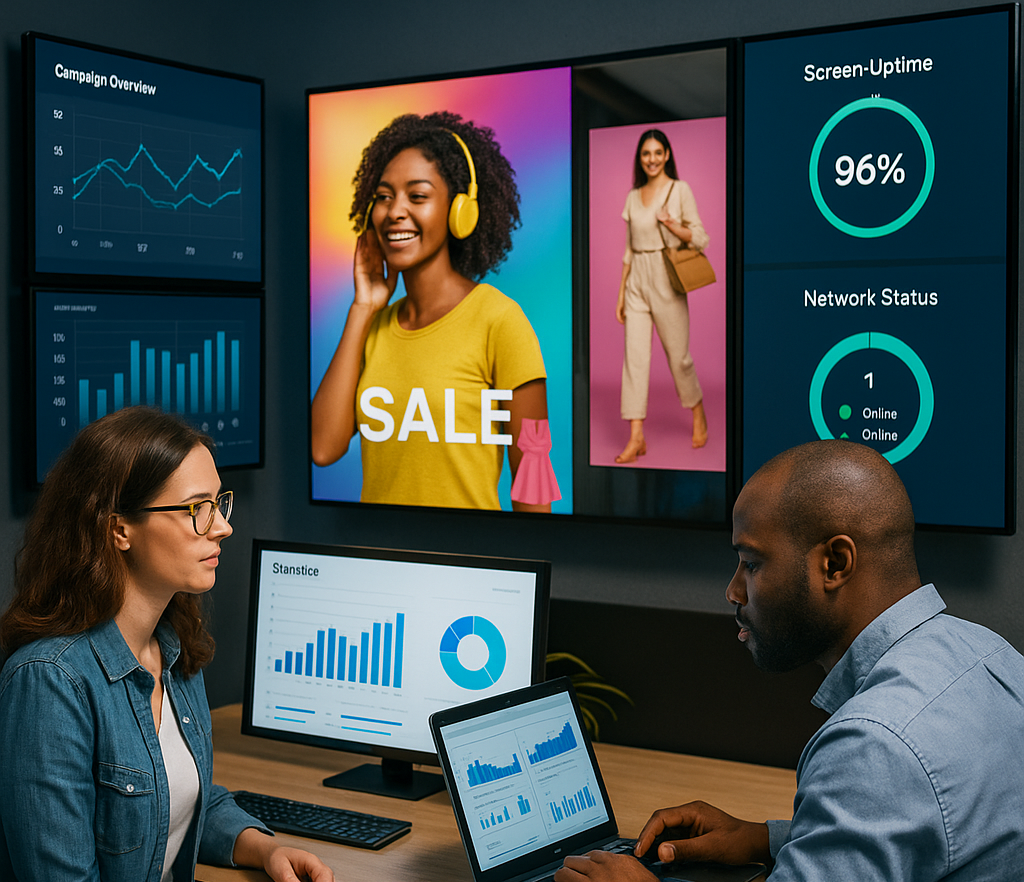-
Table of Contents
Introduction
A Digital Signage player is specialized hardware or software for displaying multimedia content on digital screens. It acts as the intermediary between the content management system (CMS) and the display. It ensures the right content is shown at the right time. These players handle various media types, including images, videos, text, and interactive elements. They are used in retail, corporate, educational, and public spaces to deliver targeted messages. Digital Signage players often feature remote management, scheduling, and real-time updates. This makes them a versatile tool for dynamic and engaging visual communication.
How To Choose The Right Digital Signage Player For Your Needs
Choosing the right digital signage player can be daunting due to the many options available. This player is crucial in any system, delivering content to your display screens. It acts as the bridge between your content management system (CMS) and the display, ensuring your messages are conveyed effectively and efficiently. Therefore, understanding the key factors to consider when selecting a player is essential for achieving your communication goals.
First and foremost, it is important to assess the type of content you plan to display. Different players support various formats and resolutions, so knowing whether you will be showcasing static images, videos, or interactive content will help narrow down your choices. For instance, if your content includes high-definition videos or complex animations, you will need a player with robust processing power and ample storage capacity. Conversely, for simpler content like text and images, a basic player with standard specifications might suffice.
Another critical consideration is the operating environment. The location and conditions where the player will be installed can significantly impact its performance and longevity. For outdoor installations, you will need a player that is weatherproof and can withstand extreme temperatures. In contrast, indoor environments may require players with features like fanless cooling systems to ensure silent operation. Additionally, if your screens will be placed in high-traffic areas, opting for a player with a durable build and reliable performance is advisable.
Connectivity options are also a vital aspect to evaluate. Players come with various connectivity features, including Wi-Fi, Ethernet, and Bluetooth. Depending on your network infrastructure and the ease of installation, you may prefer one connectivity option over another. For instance, Wi-Fi-enabled players offer the advantage of wireless setup, making them ideal for locations where running cables is impractical. On the other hand, Ethernet connections provide more stable and faster data transfer, which is crucial for streaming high-quality content.
Furthermore, the compatibility of the player with your existing CMS is paramount. Ensuring that the player seamlessly integrates with your CMS will streamline the process of uploading, scheduling, and managing content. Some players come with proprietary software, while others are compatible with a range of third-party CMS platforms. It is essential to verify this compatibility to avoid any potential issues that could disrupt your operations.
Scalability is another factor to consider, especially if you plan to expand your network in the future. Choosing a player that can support multiple screens and can be easily upgraded will save you time and resources in the long run. Look for players that offer features like multi-screen support and remote management capabilities, which will allow you to control and monitor your network from a central location.
Lastly, budget constraints will inevitably influence your decision. While it may be tempting to opt for the cheapest option available, it is important to balance cost with quality and functionality. Investing in a reliable and feature-rich player may have a higher upfront cost, but it will pay off in terms of performance, durability, and ease of use.
In conclusion, selecting the right player involves considering your content requirements, operating environment, connectivity options, CMS compatibility, scalability, and budget. By thoroughly evaluating these factors, you can make an informed decision. This will enhance the effectiveness of your screens and help you achieve your communication objectives with confidence.
Benefits Of Using Digital Signage Players For Businesses

Digital signage players have become an indispensable tool for businesses looking to enhance their communication strategies and engage with their audience more effectively. These devices, which are essentially media players designed to display digital content on screens, offer a myriad of benefits that can significantly impact a business’s operations and customer experience. One of the primary advantages of using digital signage players is their ability to deliver dynamic and visually appealing content. Unlike traditional static signs, digital signage can display videos, animations, and interactive content, capturing the attention of passersby and making the message more memorable. This dynamic nature allows businesses to convey complex information in a more engaging and digestible format, which can be particularly beneficial in retail environments where attracting and retaining customer attention is crucial.
Moreover, these players offer unparalleled flexibility and ease of content management. Businesses can update their displays in real-time, ensuring that the information presented is always current and relevant. This is especially useful for promoting special offers or any time-sensitive information that businesses need to communicate promptly. Scheduling content in advance also allows businesses to plan their marketing strategies more effectively, ensuring they deliver the right message at the right time. This level of control over content not only enhances the customer experience but also allows businesses to respond quickly to changing market conditions or customer preferences.
In addition to improving customer engagement, these players can also lead to significant cost savings. Traditional print signage requires regular updates and replacements, which can be both time-consuming and expensive. Digital signage, on the other hand, eliminates the need for physical materials and reduces the associated labor costs. Furthermore, the initial investment in digital signage players and displays can be offset by the long-term savings on printing and distribution costs. This makes digital signage a cost-effective solution for businesses of all sizes, from small retail stores to large corporate enterprises.
Another notable benefit of digital signage players is their ability to collect and analyze data. Many modern digital signage systems come equipped with analytics tools that track viewer engagement and interaction. This data can provide valuable insights into customer behavior, preferences, and trends, allowing businesses to tailor their content and marketing strategies more effectively. By understanding what resonates with their audience, businesses can create more targeted and impactful campaigns, ultimately driving higher engagement and conversion rates. Furthermore, digital signage players can enhance internal communication within a business. In corporate environments, digital displays can be used to share important announcements, company news, or performance metrics with employees. This can foster a more connected and informed workforce, improving overall productivity and morale. In addition, digital signage can be used for training purposes, providing employees with access to instructional videos or other educational content.
Lastly, the integration capabilities of digital signage players make them a versatile addition to any business’s technology ecosystem. They can be easily integrated with other systems, such as point-of-sale systems, social media feeds, or customer relationship management (CRM) software. This integration allows for a seamless flow of information and ensures that the content displayed is always relevant and up-to-date.
In conclusion, the benefits of using digital signage players for businesses are manifold. From enhancing customer engagement and improving content management to reducing costs and providing valuable data insights, digital signage players offer a powerful tool for businesses looking to stay competitive in today’s fast-paced market. Their versatility and ease of use make them an attractive option for businesses across various industries, helping them to communicate more effectively and achieve their marketing goals.
Key Features To Look For In A Digital Signage Player
When selecting a digital signage player, understanding the key features to look for is crucial to ensure you make an informed decision. A digital signage player is a device that displays multimedia content on digital screens, and its effectiveness can significantly impact the success of your digital signage strategy. One of the primary features to consider is the device’s compatibility with various media formats. A versatile digital signage player should support a wide range of file types, including images, videos, and HTML5 content, to provide flexibility in the types of content you can display.
Another essential feature is the device’s processing power. A robust processor ensures smooth playback of high-definition content and prevents lag or stuttering, which can detract from the viewer’s experience. Additionally, the player should have sufficient storage capacity to handle large media files and playlists, allowing for uninterrupted content delivery. Transitioning to connectivity options, a good digital signage player should offer multiple connectivity ports, such as HDMI, USB, and Ethernet, to facilitate easy integration with various display screens and network configurations.
Moreover, the ability to manage content remotely is a significant advantage. Look for a digital signage player that supports cloud-based content management systems (CMS). This feature allows you to update and schedule content from any location, providing convenience and efficiency, especially for businesses with multiple locations. Furthermore, the player should offer robust security features to protect your content and network from potential threats. Encryption, secure login credentials, and regular firmware updates are critical components of a secure digital signage solution.
In addition to these technical specifications, ease of use is another important consideration. A user-friendly interface simplifies the process of uploading, scheduling, and managing content, reducing the learning curve for your team. Some digital signage players offer drag-and-drop functionality, simplifying playlist creation and modification. Choose a scalable digital signage player that grows with your business. The player should support screen expansion and advanced features without needing a complete system overhaul.
Energy efficiency is another factor to consider, as it can impact your operational costs. Look for a digital signage player that is designed to consume minimal power while delivering optimal performance. This not only helps in reducing energy bills but also contributes to a more sustainable business practice. Additionally, the player should be durable and reliable, capable of operating continuously without frequent maintenance or downtime. This ensures that your digital signage remains effective and engaging at all times.
Lastly, consider the level of customer support and warranty offered by the manufacturer. A reliable support system can provide peace of mind, knowing that any technical issues will be promptly addressed. A comprehensive warranty also protects your investment, ensuring that you receive a quality product that meets your expectations.
In conclusion, selecting the right digital signage player involves evaluating key features such as media compatibility, processing power, connectivity options, remote management capabilities, security, ease of use, scalability, energy efficiency, durability, and customer support. By carefully considering these factors, you can choose a digital signage player that meets your current needs and supports your future growth and success.
Digital signage players are integral components in the realm of digital advertising and information dissemination. These devices serve as the backbone of digital signage systems, enabling the display of dynamic content on screens in various settings. Retail stores, corporate offices, public transportation hubs, and educational institutions use them. Understanding the basics of digital signage players involves exploring their functionality, types, and benefits.
At its core, a digital signage player is a specialized hardware device designed to deliver multimedia content to digital displays. These players handle various content formats, including images, videos, text, and interactive elements, ensuring the displayed information is engaging and informative. The primary function of a digital signage player is to decode and render content stored locally or streamed from a network. This transforms static screens into vibrant, dynamic communication tools.
Transitioning to the types of digital signage players, it is important to note that they come in various forms, each tailored to specific needs and environments. Standalone players store and play content directly from internal storage or connected USB drives, making them ideal for smaller setups with limited network connectivity. In contrast, networked players connect to a central server or cloud-based platform, enabling remote content management and updates. This type is beneficial for large-scale deployments where consistency and real-time updates are crucial.
Moreover, system-on-chip (SoC) players are an emerging category that integrates the player directly into the display hardware. This integration reduces the need for external devices, streamlining the setup and minimizing potential points of failure. SoC players are becoming increasingly popular due to their compact design and ease of use. Additionally, designers create specialized players for specific applications, such as interactive kiosks or video walls, offering enhanced capabilities to meet unique requirements.
Understanding the benefits of digital signage players further underscores their importance. One of the most significant advantages is the ability to deliver targeted, real-time content. Businesses can tailor their messages to specific audiences, ensuring that the information is relevant and impactful. For instance, a retail store can display promotions based on the time of day or inventory levels. This maximizes sales opportunities. Similarly, corporate offices can use digital signage to communicate important announcements. They can also display performance metrics to employees, fostering a more informed and engaged workforce.
Another notable benefit is the ease of content management. Modern digital signage players often come with user-friendly software that allows for seamless content scheduling, updates, and monitoring. This capability is particularly valuable for organizations with multiple locations, as it ensures consistency and coherence across all displays. Furthermore, the ability to remotely manage content reduces the need for on-site maintenance, saving both time and resources.
In addition to these practical benefits, digital signage players also contribute to an enhanced customer experience. By providing visually appealing and interactive content, businesses can capture the attention of their audience and create memorable interactions. This engagement can lead to increased brand loyalty and customer satisfaction, ultimately driving business growth.
In conclusion, digital signage players are pivotal in transforming traditional displays into dynamic communication platforms. Their versatility, ease of use, and ability to deliver targeted content make them indispensable tools in various industries. As technology continues to evolve, digital signage players will undoubtedly play an even more significant role in shaping the future of digital communication.
Q&A
1. What is a Digital Signage Player?
A Digital Signage Player is a device or software that displays multimedia content on digital screens, such as advertisements, information, or entertainment, often used in public spaces.
2. What types of content can a Digital Signage Player display?
A Digital Signage Player can display various types of content including videos, images, text, web pages, social media feeds, and live TV.
3. What are the common uses of Digital Signage Players?
Common uses include advertising in retail stores, informational displays in corporate offices, wayfinding in transportation hubs, and menu boards in restaurants.
4. What are the key features to look for in a Digital Signage Player?
Key features include content scheduling, remote management, multi-zone screen layouts, compatibility with various media formats, and real-time updates.</p>
Conclusion
A Digital Signage player is a specialized hardware or software solution designed to display multimedia content on digital screens. It serves as the intermediary between the content management system (CMS) and the display. It ensures the system shows the right content at the right time. These players can handle various media formats, and support scheduling, and often include features for remote management and real-time updates. They are essential components in digital signage networks. These are used in retail, corporate environments, public spaces, and transportation hubs. They deliver dynamic and engaging visual communications.


